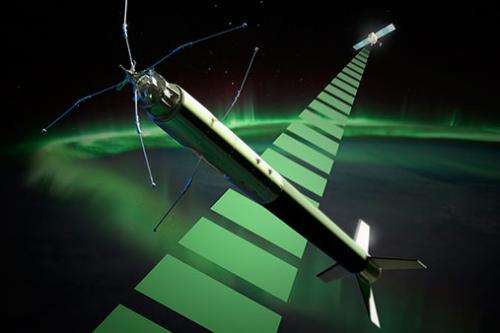Sending a rocket through the northern lights

The combination of American electron clouds and Norwegian northern lights spells trouble for navigation and communication in the Northern regions. The ICI4 rocket will provide knowledge that can help us predict the weather in space.
Solar flares give rise to more than just the northern lights: on the Earth's day side, sunlight tears electrons loose from the atmosphere. Complete clouds of electrons are formed and drift across the Arctic. These electron clouds are invisible to our eyes, but they appear on radar screens and in super-sensitive cameras made to capture the northern lights.
When night falls in Norway, electron clouds are formed over North America. After only a few hours, the electron clouds have reached our lands, since they are drawn out of the polar region by the nightly northern lights. Beautiful to observe, but disruptive for navigation and communication systems.
Researchers from the University of Oslo, Norway, have found that the most serious interferences occur when electron clouds coincide with the northern lights. They now want to explore these "freak" events by taking measurements from on board a rocket.
Weather forecast for outer space
"We wished to find the causes of these interferences," says Jøran Moen, Project Director. "We need this knowledge to establish a forecasting system for space weather."
Disturbances of the magnetic field in the Northern regions pose a considerable risk for all those who are dependent on precise navigation and continuous communication, in the air as well as on the open sea.
Today, there is no technology available that can eliminate this problem, nor do we have sufficient knowledge to be able to provide advance warnings that are of any practical use.
The ICI-4 research rocket is intended to help increase our knowledge in this field. On 9 February the rocket will be ready to blast off from Andøya Space Center's launch pad. As soon as the phenomenon occurs of electron clouds coinciding with the northern lights, the rocket will fly through the northern lights and make its measurements.
Instruments for ESA and NASA
One of the instruments on board has been developed at UiO and selected by the European space agency ESA for its space weather programme. The instrument is also used on board some of NASA's rockets. The Norwegian electronics firm Eidel is refining the instrument for use in space exploration.
More information: Follow the scientists live-blogging the attempt to launch the rocket on facebook.com/ici4rocket and twitter: #ICI4
Provided by University of Oslo




















